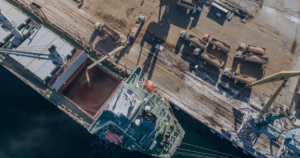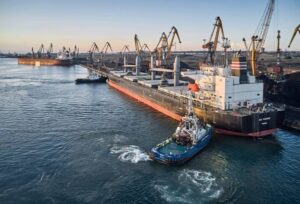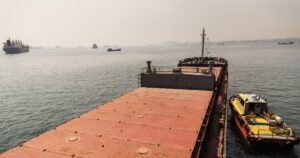
On December 2, PJSC Ukrnafta announced a tender for insurance services covering the liability of dangerous goods transporters in the event of negative consequences during the transportation of such goods.
According to the Prozorro electronic public procurement system, the expected cost of purchasing the services is UAH 471,691 thousand.
Documents will be accepted until December 10.
Ukrnafta JSC is Ukraine’s largest oil production company and operates the largest national network of gas stations, UKRNAFTA. In 2024, the company entered into asset management with Glusco. In 2025, it completed an agreement with Shell Overseas Investments BV to purchase the Shell network in Ukraine. In total, it operates 663 gas stations.
The company is implementing a comprehensive program to restore operations and update the format of gas stations in its network. Since February 2023, it has been issuing its own fuel vouchers and NAFTAKarta cards, which are sold to legal entities and individuals through Ukrnafta-Postach LLC.
The largest shareholder of Ukrnafta is Naftogaz of Ukraine with a 50%+1 share.
In November 2022, the Supreme Commander-in-Chief of the Armed Forces of Ukraine decided to transfer the company’s corporate rights, which belonged to private owners, to the state, and they are now managed by the Ministry of Defense.

Thanks to the Ukrainian maritime corridor, the ports of Greater Odessa have handled over 146.5 million tons of cargo and processed 5,596 vessels since August 2023, including 1,528 through the port of Odessa, according to Dmytro Nazarenko, head of the Odessa branch of the State Enterprise “Administration of Seaports of Ukraine.”
“Despite all the challenges, Ukrainian seaports remain an integral part of the country’s economic stability. Their security is not only a matter of logistics, but also the survival of Ukraine’s export model,” he said at a round table of representatives of the maritime and port industry, which took place within the framework of the BALTEXPO 2025 International Maritime and Military Exhibition in Gdansk (Poland).
Nazarenko noted that since the start of full-scale aggression in Ukraine, more than 500 port infrastructure facilities and 116 civilian vessels have been damaged or destroyed, 157 civilians have been injured, and 161 facilities have been damaged directly on the territory of the Odesa seaport.
The USPA representative presented the European community with infrastructure projects for the Port of Odesa and plans for their further implementation, and invited international investors to cooperate.

In Kabul, Uzbekistan and Afghanistan have established a joint venture for freight transportation—Sogdiana Trans LLC.
Sogdiana Trans LLC was founded by O‘zbekiston temir yo‘llari JSC and specializes in freight transportation, management, and technical maintenance of the Khairaton–Mazar-i-Sharif–Noibabad railway line.
At the opening ceremony of the joint venture, Hamid Khan, head of Khan Daqiq Trading, said that the company has the capacity to transport 150,000 tons of products per year by road along the Kabul–Mazar-i-Sharif –
Kabul, as well as from Mazar-i-Sharif by rail to Uzbekistan, Kazakhstan, the Baltic countries, and others, and to import products from there.
During the event, the head of the logistics and marketing department of Sogdiana Trans LLC expressed his gratitude to the President of Uzbekistan Shavkat Mirziyoyev and the management of O‘zbekiston temir yo‘llari JSC for the opportunities created for entrepreneurs in the Year of Environmental Protection and Green Economy.
AFGHANISTAN, CARGO, joint venture, TRANSPORTATION, UZBEKISTAN

Almost 5,000 vessels have handled over 130 million tons of cargo, including 80 million tons of grain, since the launch of the Ukrainian corridor in the Black Sea, said Oleksandr Semyryga, head of the Ukrainian Sea Ports Authority (USPA), during a visit to Odesa seaport by German Federal Foreign Minister Johannes Wadefuhl and Ukrainian Foreign Minister Andriy Sybiga.
“Since the launch of the Ukrainian Corridor, almost 5 thousand vessels have been handled and over 130 million tons of cargo have been transshipped. Of these, more than 80 million tons are grain. The port infrastructure is constantly under enemy attack, with shelling taking place every week. But every employee in the industry understands the importance of their work and the role that Ukrainian ports play in maintaining global food and logistics security,” Semyryga was quoted as saying by the USPA press service.
The ministers also inspected the building of the Odesa Sea Port, which was damaged by a Russian missile strike in September 2023. Semyryga clarified that the attacks are systemic – since July 2023 alone, more than 80 attacks on port infrastructure facilities in Odesa region have been recorded.

In January-March 2025, Ukrainian ports reduced the volume of cargo handled by 17.2% compared to the same period last year – to 23 million tons.
“In the first quarter of 2025, Ukrainian ports handled 23 million tons of cargo… For comparison, in the first quarter of 2024, Ukrainian ports handled 27.8 million tons of cargo, 4.8 million tons more than this year,” the state-owned Ukrainian Sea Ports Authority (USPA) said on Facebook on Wednesday.
“The decrease in cargo turnover is due to the reduction of farmland and a decline in production in export-oriented industries, in particular metallurgy, which exported up to 80% of its products before the war,” the USPA said.
It is noted that global cargo transshipment is also declining due to market volatility and logistics disruptions.
According to the report, the largest volumes of cargo were handled by the ports of Greater Odesa. Since the beginning of 2025, they have handled 20.7 million tons of cargo: Pivdennyi port – 10.6 million tons, Chornomorskyi port – 6.6 million tons, Odesskyi port – 3.5 million tons.
The ports of Izmail, Reni and Ust-Dunaisk in the Danube region handled over 2.3 million tons of cargo.
Despite the shelling and threats from the Russian army, the ports continue to operate steadily thanks to the coordinated work of port workers. The Armed Forces of Ukraine and the Navy of the Armed Forces of Ukraine ensure the safety of navigation, the USPA emphasized.
Earlier, Oleksiy Kuleba, Vice Prime Minister for the Restoration of Ukraine and Minister of Community and Territorial Development, said that as of April, 116 million tons of cargo had been transported through the Ukrainian sea corridor, including almost 73 million tons of grain. In early March, the Ministry of Development reported that 106 million tons of cargo had been transported through the Ukrainian sea corridor, including almost 70 million tons of grain.

The Ukrainian Sea Corridor has transported 116 million tons of cargo since its launch, including almost 73 million tons of grain, said Oleksiy Kuleba, Vice Prime Minister for Reconstruction of Ukraine and Minister of Communities and Territories Development.
“Since the launch of the Ukrainian Sea Corridor, 116 million tons of cargo have been transported. Of these, more than 73 million tons of grain have been transported to the countries of Europe, Africa and Asia,” Kuleba wrote on Facebook on Tuesday following the visit of President of Ukraine Volodymyr Zelenskyy to Odesa region.
At the same time, since the summer of 2023 alone, Russia has fired more than half a thousand missiles at our ports and damaged about 400 port infrastructure facilities, Kuleba noted in his Facebook post.
Kuleba also took part in a working trip, the press service of the Ministry of Communities and Territories Development said in a statement.
The Deputy Prime Minister said that in Odesa, Zelensky held a meeting on the security situation in the region and its socio-economic development. The focus was on people’s safety, protection of the sky over the region from Russian attacks, the situation with grain exports, the work of regional enterprises and support for our people.
“It is also important for us to protect the port infrastructure. This is a matter of Ukraine’s economy and global food security,” Kuleba emphasized, noting that strengthening protection against constant Russian attacks and stable operation of the sea corridor is of course of interest to the region’s producers.
Work is currently underway to strengthen the air shield over Odesa region. The state is also constantly working on security guarantees, in particular at sea, in the sky, and on land, the Deputy Prime Minister said in a post.
In early March, the Ministry of Development reported that 106 million tons of cargo had been transported through the Ukrainian sea corridor during its operation, of which almost 70 million tons were grain.
It was also reported that on Tuesday, NATO Secretary General Mark Rutte visited Odesa together with Ukrainian President Volodymyr Zelenskyy.